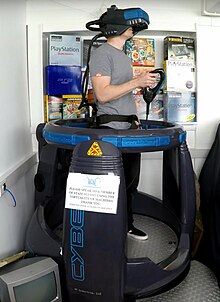User:Happysammimeng/sandbox
[[Virtual Reality]]
[edit]Definition of Virtual Reality
[edit]
Virtual Reality (VR for short) means “virtual reality”. With the help of a computer and special glasses, VR glasses, you will be shown a different reality. You see a digital, computer-generated and three-dimensional environment through the VR glasses. You can often move around and interact in them. The realistic impression is further enhanced by the corresponding sounds that you hear through a VR headset. You use special controllers to interact with the virtual world.
Virtual reality affects industry, research, medicine and of course the entertainment industry Classic virtual reality headsets to outwit the brain as best as possible. This is how the fusion of the virtual and real world works.
VR applications are already being used in many areas. The possibility of playing video games with VR glasses and experiencing the action yourself is very well known. The applications are also available in escape rooms, for example, to enable a special experience of the game. The technology is also used at trade fairs or in museums, for example to let visitors experience bird flight or to enable them to experience historical events. VR is also used for training purposes, for example in driving training or to practice first aid measures in realistic scenarios. On the one hand, digital technology serves to enable people to experience experiences that they would not normally be able to have. On the other hand, VR is used to simulate real situations and thus enable training without real consequences.
Application of virtual reality in education
1. Increase student engagement
Immersive VR classrooms are equipped with adequate means to make learning more engaging and communicative, which helps increase student engagement. The more interactive and communicative the class, the more enthusiastic the participants will be about learning. The traditional approach of reading and learning theory may not interest all students, but a virtual reality setup is a comprehensive and fun approach where students can watch things, connect with them, and become a part of whatever they are working on Come learn things easily and simply. In learning, they can see 3-dimensional images and through other technologies like IoT in education, it can be made more technologically advanced and engaging.
2. High Tech Training
Virtual reality can be used to deliver high-tech based professional training that educates people on the practical aspects of execution. They create a realistic atmosphere for enrollees to practice for real-time situations. They used virtual reality landscapes combined with equipment that might be used in real-time situations, connected to wireless systems that appeared to move within the training VR screen as they would in real life.
In the military, virtual reality can be used to practice real-time combat situations or conduct combat exercises before becoming part of actual training. Virtual procedures, treatment descriptions and 3D demonstrations can be practiced in medical training. A better understanding and perspective of human anatomy. Not only in these two areas, VR can also be used in other training courses such as mechanics, disaster management and even virtual laboratories to understand the situation in detail and practice safe and cost-effective learning methods.
Literatur:
[edit]Oliver Grau: Virtual Art. From Illusion to Immersion. MIT Press, Cambridge 2003, ISBN 0-262-07241-6.
[edit]Sonja Klimek: Illusion, Immersion und Identifikation im Erzähl-Rollenspiel. In: Colloquium Helveticum. Jahrbuch der Schweizerischen Gesellschaft für Allgemeine und Vergleichende Literaturwissenschaft. Band 43, 2012, S. 244–266.
References:
[edit]https://www.heise.de/tipps-tricks/Was-ist-Virtual-Reality-6006456.html#VR
Virtual Reality – eine technologische Revolution steht an | Einstein | SRF (youtube.com)
